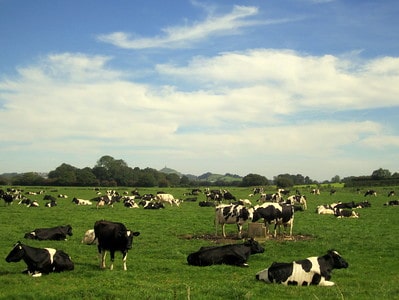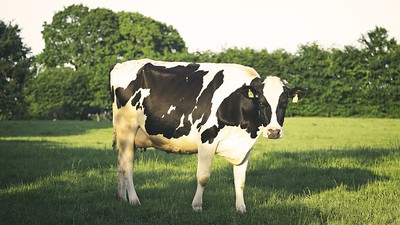Originating from Duch provinces and Northern Germany, Holsteins are docile dairy animals with impressive features. Let’s learn more about them.
Holstein Friesians are large animals, easily recognized by their bulky body and well-defined dual-colored markings. These cattle are the largest producer of milk and are commonly found in Continental Europe and the United States, among other regions. Their milk is widely distributed on a global scale.
Key Takeaways:
| Aspect | Holstein Cows |
|---|---|
| Physical Characteristics | – Black eyelids |
| – Black muzzle | |
| – Black or dark gray hooves | |
| – Tail color: brown, black, or white | |
| – Small to medium-sized hump | |
| – Red-and-white or black-and-red coloring | |
| – Coat color: brown, black, gray, or white | |
| – Weight: 580 to 700 kg (approximately) | |
| – Prominent naval flap and dewlap | |
| – Height: Around 4 feet, 10 inches | |
| What Are Holstein Cows Known For? | – Largest milk producer among cattle breeds |
| – Worldwide distribution of milk | |
| – Source of ground beef and roast beef | |
| Why Are Holsteins So Popular? | – High milk production (approx. 30 kgs) |
| – Genetic superiority and adaptability | |
| – Supply of a large quantity of beef | |
| Disadvantages of Holstein Cows | – Low buttermilk content in milk |
| – Low reproductive efficiency (2 to 4 years) | |
| – Short lifespan (4 to 6 years) | |
| Are Holsteins Friendly? | – Friendly and good-natured |
| – Easily adaptable and not prone to hostility | |
| – Prefer to live with other cows | |
| – Display herd mentality | |
| What Is the Temperament of Holsteins? | – Agreeable and easy to tame |
| – Calm and friendly | |
| – Less intelligent but observant and curious | |
| – Easy to manage and milk | |
| Can Holsteins Be Red? | – Yes, if they have the red coat gene |
| – Red coloring caused by recessive genes | |
| Can Holsteins Be All Black? | – No, they are either black and white or |
| red and white | |
| – Holsteins are a product of cross-breeding | |
| How Big Do Holsteins Get? | – On average, around 4 feet, 10 inches tall |
| – Weigh about 1500 pounds (varies) | |
| – Live for 4 to 7 years | |
| – Grow throughout their lifetime |
There is a lot of curiosity regarding the physical characteristics, behavioral patterns, and lifestyle of Holsteins. So, let’s explore all about it.

Holstein physical characteristics
Holsteins are among the most important cattle breeds known for their large size and unique features. Let’s look at their distinguishable characteristics:
Some of the chief physical characteristics of holsteins are:
- Holsteins are characterized by their black eyelids.
- They have a black muzzle.
- Holsteins usually have black or dark gray hooves.
- Their tail is either brown, black, or white in color.
- Holsteins have a small to medium-sized hump.
- They have red-and-white or black-and-red coloring patterns.
- Holsteins have a coat color that is either brown, black, gray, or white.
- They are bulky animals, weighing around 580 to 700 kgs.
- Holsteins have a prominent naval flap and dewlap.
- Most Holsteins are around 4 feet, 10 inches tall.
The physical characteristics of Holsteins make them stand out from other cattle breeds and give them a distinctive appearance. So, it’s easy to spot a Holstein when you see one.
What are Holstein cows known for?

Holstein cows are easy-to-recognize animals, thanks to their unique appearance. But, there’s more to them than that. Let’s check out.
Holsteins are a dairy breed known for producing the largest quantity of milk among all other cattle breeds. The milk of Holsteins is distributed worldwide, and these animals have gained the reputation of being the biggest producer of milk. Ground beef and roast beef are also derived from these animals.
Holsteins are one of the chief sources of yield in several regions around the world and are primarily responsible for the unhindered functioning of milk supply chains globally.
Why are Holsteins so popular?
Holsteins have distinct markings and other physical characteristics. But, that’s not what they’re primarily known for. Let’s learn more about why they’re so popular.
The popularity of Holsteins can largely be credited to their higher than average milk production (approx 30 kgs), through which they contribute to the annual yield of dairies. They are also genetically superior and can quickly adapt to environmental conditions. In addition, they also supply a huge quantity of beef.
All in all, holsteins are very useful and versatile creatures who are responsible for supplying meat and milk on a global scale.
What are the disadvantages of Holstein cows?
Although Holsteins are extremely beneficial, they have a few minor disadvantages. Let’s understand more about this.
The milk of Holstein cows has low buttermilk content, which can be a huge drawback in terms of nutrition. In addition, they are not very efficient reproductively and have a productive lifespan of merely 2 to 4 years. They also have a short lifespan (4 to 6 years) like most dairy cows.
All said and done, the advantages of Holsteins far outweigh their disadvantages, and they’re highly prized for their milk and beef supply.
Are Holsteins friendly?

A commonly asked question is whether Holsteins are friendly animals. Let’s explore more on this topic together.
Holstein cows are friendly and pretty good-natured, which makes them easy to handle. They easily adapt to different living conditions and are not prone to hostile behavior. In addition, they do not stress out and prefer to live with other cows. They display a herd mentality and are not solitary creatures.
Overall, Holsteins are wonderful animals who are gentle and friendly as long as they do not feel threatened by you.
What is the temperament of a Holstein cow?
It is a well-known fact that Holsteins have numerous advantages, but what is their temperament? Let’s find out.
Holstein cows are agreeable animals who are easy to tame and milk. They remain calm, are friendly but are believed to be less intelligent than most dairy animals. However, they are pretty observant and curious but adopt a laid-back attitude and mostly keep to themselves. They are also easy to milk.
All in all, Holstein cows are unlikely to bother you. They’re easy to manage and remain calmly in the stables.
Can Holsteins be red?
One of the distinctive characteristics of Holstein cows is their unique coloring. Let’s find out if they can be read.
Holsteins can be red if they have the recessive or dominant red coat gene. Most red cattle are Holsteins, but some other cattle like Milking Shorthorns or Ayrshire also contain reddish coats. The red coloring is quite common among cattle and is usually caused by the recessive genes.
Can Holstein cows be all black?
Holsteins are large animals with two different colorings on their body. But, can they be all black? Let’s find out.
Holsteins cannot be all black. They are either black and white or red and white. Most dairy cows carry two different colors on their body, but there are some cows like the Aberdeen Angus that have primarily black markings. Holsteins are a product of cross-breeding, which is responsible for their unique coloring pattern.
You’ll also find Holstein cows that are reddish-brown, tan, and brownish gray, but black, red, and white remain the most commonly spotted colors.
How big do Holsteins get?
Holsteins are large, wondrous creatures who have bulky appearances. Let’s find out how big they get.
On average, Holsteins are around 4 feet, 10 inches tall and weigh about 1500 pounds. However, there are some exceptions to the norm, and some Holsteins can grow above 5 feet and are pretty heavy, weighing over 1500 pounds. This cattle breed lives for 4 to 7 years.
All in all, Holsteins have a distinct appearance and are large cows who continue to grow throughout their lifetime. Although they’re not very tall, their weight adds to their overall appearance.
Conclusion
Holsteins form the major chunk of dairy cows globally and contribute largely towards the annual yield in various countries. They are quite expensive, owing to their numerous advantages.
These cows are beautiful, with dappled patterns of white and red or black and red. They are not solitary creatures and seek company wherever they go. The best part about them is that they’re calm, hardy, and gentle. These creatures prove to be least bothersome, and even beginners can easily work with them.
Holstein bulls can be difficult to handle, but dairy farmers today use artificial insemination for breeding the cows, and as such, life has become much easier for them. All in all, Holsteins are responsible for the uninterrupted milk supply in various countries and are highly esteemed worldwide.





